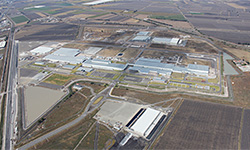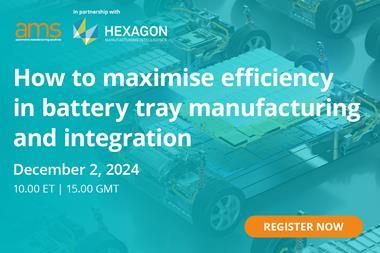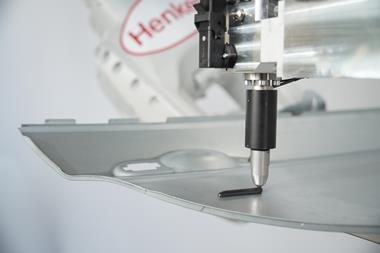 Mazda Motor Europe’s new vice-president of R&D, Kenichiro Saruwatari, leads a team of 80 engineers at its R&D centre in Oberursel, Germany. He took up his post in February, after spending almost five years as programme manager at Mazda Motor Corporation’s Product Division in Japan. Saruwatari joined the company in 1987 and has occupied roles in powertrain development, engineering and testing.
Mazda Motor Europe’s new vice-president of R&D, Kenichiro Saruwatari, leads a team of 80 engineers at its R&D centre in Oberursel, Germany. He took up his post in February, after spending almost five years as programme manager at Mazda Motor Corporation’s Product Division in Japan. Saruwatari joined the company in 1987 and has occupied roles in powertrain development, engineering and testing.
Glenn Brooks (GB): How much input does the European R&D Centre have into Mazda’s major models?
Kenichiro Saruwatari (KS): In my previous role, I was in charge of developing the new Axela/Mazda3, and previously, the model before it. It is our global bestseller. Basic engineering is done in Japan, but there is much testing in Europe.
GB: Does that apply for all vehicles, even ones such as the MPV/Mazda8 which are not sold in Europe?
KS: No, models which are not sold in Europe will not necessarily undergo extensive testing here.
GB: There is an obvious gap in the brand’s model range. If you were to launch a ‘CX-3’ [Nissan Juke rival], where would the main engineering be done?
KS: Models which will sell mainly in Europe, we take responsibility for these. I cannot speak about future vehicles – are they being developed, are they not – but we have announced that there will be a new MX-5 and yes, our R&D centre is involved with that car.
"We are just starting to develop the seventh-generation models. This will mean more lightweight materials, like aluminium, magnesium and others." - Kenichiro Saruwatari, Mazda Motor Europe
GB: Why did the company develop the new SKYACTIV-D 1.5 in-house? Surely it would have made more sense to source a small diesel from another OEM?
KS: For a very simple reason: in the European market, we need a small diesel for our customers.
GB: But Mazda is not a big, cash-rich company. How could the R&D investment be justified?
KS: If we’re talking about engine development, other companies might use shared components; for example the block and head. But in the Mazda way, we always focus on the combustion itself. Combustion is very important. So, our approach is this: even if we have many engines, the combustion character is the same.

GB: What role does the team at Oberursel have in the ongoing development of the SKYACTIV-D 1.5?
KS: Of course, we have a major role. But we have not yet launched SKYACTIV-D 1.5, we have just displayed it. Right now, I cannot discuss the details of this engine.
GB: Will it be launched in the next Demio/Mazda2? Next year?
KS: This year.
"Sales volumes of fuel cell cars will be very low. It is better for us to keep developing our engines which can reduce emissions globally." - Kenichiro Saruwatari, Mazda Motor Europe
GB: Mazda was one of the first OEMs to start lightweighting its cars. How do you take even more weight out of the next-generation models?
KS: Certain current models, including the CX-5, Mazda6 and the new Mazda3, we call them ‘sixth-generation’ vehicles, with SKYACTIV-BODY. All were designed under the same development philosophy. And now we are just starting to develop the next generation, the seventh-generation models. So now we are thinking about a lot of things – to reduce weight, to make the combustion more efficient. This will mean more lightweight materials, like aluminium, magnesium and others. But this causes more expense, so we must be cautious.
GB: Could you explain what SKYACTIV-BODY means?
KS: SKYACTIV-BODY is our latest front-wheel drive and all-wheel drive architecture. It has high rigidity and is lighter than previous designs. And it meets the top criteria for crash protection in all markets. In the underbody, there is a straight frame instead of curves. This is because we wanted to have a continuous configuration from the front to the rear. But, in some sections of the frame, you need to have a curve. So, we implemented continuous bonding with the horizontal frame. This makes the structure a closed section. The benefits are a highly rigid structure and [less] weight.
GB: Pressing your suppliers to reduce the weight of future components will in turn give their businesses an advantage over rivals, would you say?
KS: Yes, of course.
GB: Which region is leading the move towards lighter vehicles?
KS: Here [Europe].
GB: And yet Europe is not a major market for Mazda. How then do you convince headquarters at Hiroshima to give your Centre adequate resources to continue the lightweight technology lead?
KS: The company looks around the world and it sees where the most important regions are. Our work here is very important. So, we focus on what we do with new models, and then they spread out globally.
GB: Apart from perhaps Subaru, no other company seems to have such short product lifecycles. Why replace major vehicles every four or five years?
KS: This depends on the model. Some models’ lifecycles are short, but this depends on how many units of the vehicle we sell. If we’re talking about a Mazda3, sales are very high, so we will update the car more often.
GB: How can a vehicle-maker of Mazda’s size justify that investment every four years?
KS: In previous times, yes, this was difficult [during the period of sustained losses]. But now, that has changed. For the CX-5, Mazda6, Mazda3, the investment can be shared. We developed these models with many common components and you will see more examples. So, we can reduce manpower costs, and many other costs this way.
GB: You have a new rear-wheel drive architecture coming for the Roadster/MX-5 and for a model you will build for Fiat. Does this platform have a specific name?
KS: No.
GB: Have you shared the engineering with Fiat or will you just supply a car for them?
KS: I cannot answer this fully. Basically, we have to share.
GB: So it’s an OEM supply arrangement?
KS: Yes.
GB: What of the media reports which claim that Fiat Chrysler Automobiles (FCA) will no longer use Mazda to build an Alfa Romeo roadster, contrary to what Fiat said as recently as December?
KS: I don’t know, I cannot comment; I have heard the same thing. You must ask Fiat.
GB: The project for Fiat suggests that Mazda cannot keep funding so many R&D programmes on its own.
KS: Last year, we launched Axela Hybrid in Japan and Toyota shared its technology with us for that car. This has been a successful project. So that kind of collaboration is good for both companies.
GB: Would you supply your SKYACTIV [high-compression petrol and diesel] engines to competitors?
KS: There has been a lot of interest in this technology from other manufacturers but we do not sell it to anyone else.

KS: Yes.
GB: Returning to the next MX-5, the basic engineering is no doubt being undertaken in Japan, but how much involvement does the European R&D Centre have?
KS: Basically, the conditions in Europe are what are needed for this car: high speeds, lots of variations in road surfaces and so on. So, a lot of the evaluation has been done here, and a lot more will continue to be done here. And of course we have Nürburgring for brake testing, for road holding, for handling.
GB: We haven’t heard anything for some time on the future of the rotary. In 2017, it will be the 50th anniversary of the Cosmo Sport, Mazda’s first production car with a Wankel engine. The perfect time for a new sports car?
KS: Ah, you know the Cosmo Sport! So, let me explain. We have a lot of options for how we can use the rotary engine. Maybe next year, we might provide some technology information on how it could be used as a range extender. And you know we have already shown a Demio model prototype in Japan with this idea. We are right now thinking hard about how we can use a rotary engine in the future.
 Mazda Hazumi concept
Mazda Hazumi conceptGB: Do you have engineers working on this?
KS: Yes. But it is also an issue of manpower, so we have to focus on gasoline and diesel engines first, and then we think about developing the rotary engine.
GB: As for fuel cells, many rivals have pooled their resources – Nissan, Daimler and Ford come to mind. Is Mazda able to continue developing this technology on its own?
KS: We are always working on one thing – to make combustion more efficient. And if we keep doing this, then we can use this for different fuels. We are still continuously developing hydrogen vehicle test vehicles.
GB: Toyota, Honda and Hyundai have committed to serial production of fuel cell vehicles within the next year to two years, albeit in modest volumes. What about Mazda?
KS: Sales volumes of these cars will be very low. For us, we want to spread our technology across the globe so it can be enjoyed by a lot of people, not just a small number of people. That’s why we don’t say we will sell so many fuel cell cars this year or next year. It is better for us to keep developing our engines which can reduce emissions globally. If we keep doing this, we see that we can reduce emissions and improve fuel consumption dramatically. This is our strategy.


































